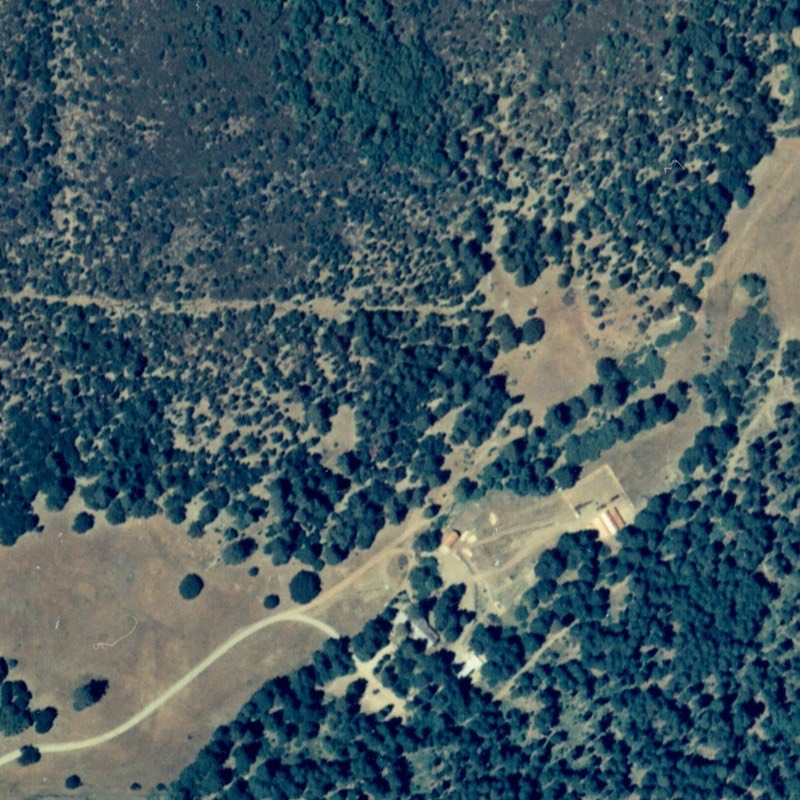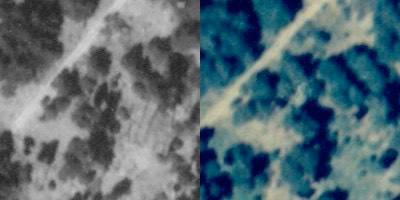January 27th, 2009
This picture was taken on June 14th, 1975. As you can see, much has changed in just nine years: somebody has build a home! The story, as I have heard it (and this is just neighborhood gossip), is that it was built by the fellow who founded a breakfast restaurant chain called Sambo’s. This was a family restaurant with a theme based on the tale of Little Black Sambo. The food was good and the chain steadily expanded during the 1960s; I recall eating at one of his restaurants in California several times. However, in the 1970s, the theme of the restaurant became somewhat uncomfortable for people; it seemed vaguely racist. So the chain slowly shrank and eventually died. The owner was forced to sell the place sometime in the 1980s. He started up a new restaurant in Medford with a studiously non-commital name and has made a decent living. He now owns a small house a couple of miles up Sterling Creek Road.

The new road really jumps out at you. It follows the same path as the old road, but now it curves down towards the creek, which it crosses. There are quite a few changes. There are now two bridges across the creek: a simple wooden plank bridge where the main road crosses, and a sturdy concrete affair with big drainage pipes about 80 meters downstream. It’s close to the most prominent building near the center of the picture, the one with an orange roof. We call that building "the shop" and it’s now my workshop; I suspect that it always had this function.
The second most prominent building in the picture is the huge barn on the right center. It’s a monster: 44 feet by 36 feet. That’s more than 1500 square feet: bigger than some houses. This is one of the finest barns I have ever seen. Most barns are built rather shoddily using old used lumber. After all, they’re just for animals, right? So who needs high standards of construction? The new owner apparently wanted a really good barn, though, because this thing will last forever. There are four big concrete pillars anchoring each of the corners. It has a solid wooden floor over a crawl space. There are four roomy paddocks and a tack room. And the hay loft is sturdily built with 8" joists every 12 inches -- that loft can support a full load of hay easily! Even today, 35 years after it was built, that barn is rock solid.
You can see a large fenced area in front of around the barn. The fence does not appear to be complete but it surely is. You can see that the soil inside it has been eaten down to nothing. The dead giveaway is the heavily trodden areas just inside the fences. Horses walk along the edge of their fencing, looking out wistfully at the green grass just out of reach. So this barn was already in use at the time the aerial photo was taken.
There are three dark stains on the ground in front of the barn. I have no idea what they are. I have examined them closely on the original photo and they are unrecognizable. My best guess is that they represent water stains from a leaking water tank for the horses -- but it’s not really plausible that somebody would have three drinking tanks. I really don’t know what they are.
Behind the shop you can see a nice garden area. It’s fenced off and the soil is somewhat darker due to watering. Growing season starts on the first of June, so any plants in this garden would be too small to show up.
The house is the largest structure but it’s hard to notice because it’s buried in the trees in front of the shop. You can make out the long axis of the house, which runs from northwest to southeast. Imagine driving along the driveway approaching the house. You take the curve and cross the creek, entering a fairly open area. The driveway you’re on continues in a big circle around the house, past the shop, over the second bridge, and back to the main driveway via the little dirt road.
When the house was first built, it had a small garage on its northwest end. After crossing the wooden plank bridge, you turned left and drove into the garage.
There’s something else to the southeast of the southeast end of the house. It’s a white structure, but I don’t know what it is. It’s on the outside of the driveway as it curves around the house. Close examination reveals only that it is white and it’s some kind of structure. Perhaps that’s a missile silo.
Remember how I mentioned in the last page that the hillside had been logged? You can see the recovery made in nine years by looking at these two closeups of the southern hillside:

Notice how the trees have filled in some of the empty space. This represents nine years of recovery. It takes a long time for a forest to recover from logging.
